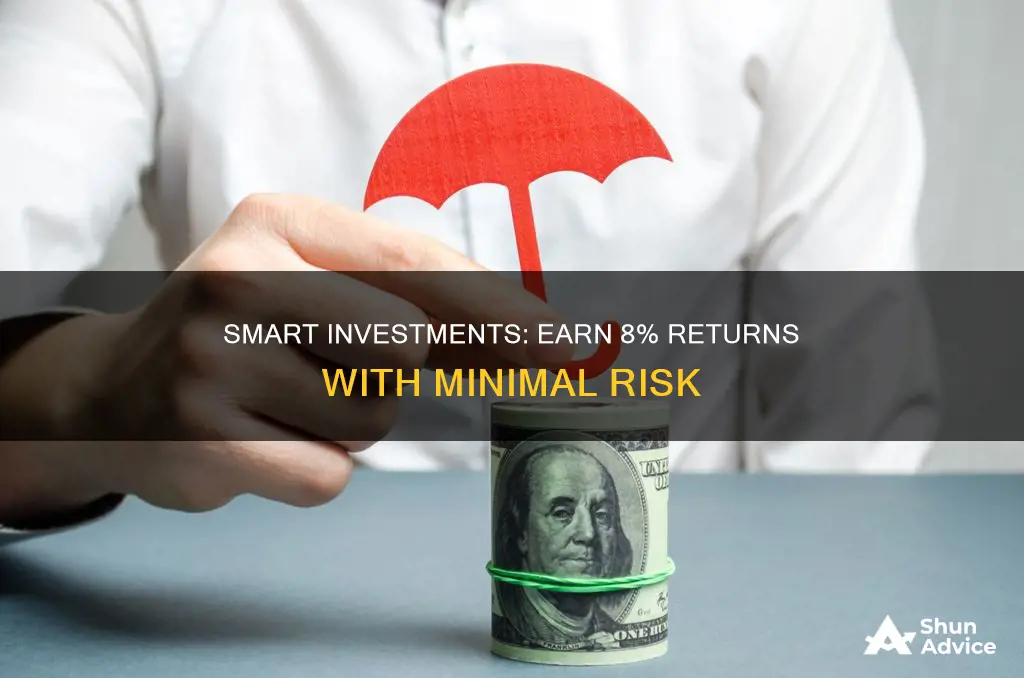
Earning 8% on investments with little risk is a challenging goal in the current market environment. While it's not impossible, it requires a careful and conservative strategy. Here are some key considerations and potential investment options to achieve this target return:
- Diversification: Diversifying your portfolio across various low-risk assets can help boost overall performance while smoothing out returns. This includes a mix of stocks, bonds, and other investments.
- Long-Term Perspective: Achieving an 8% return often requires a long-term investment horizon. Historical data suggests that average annual returns over a decade or more can reach this target, but there will be fluctuations along the way.
- Low-Risk Options:
- Treasury Bonds: These are considered low-risk and offer stable returns, but the interest rates are locked in, and there are tax implications.
- Certificates of Deposit (CDs): CDs offer fixed interest rates and are insured, but they lack liquidity, and early withdrawal may incur penalties.
- High-Yield Savings Accounts: These accounts offer higher interest rates than regular savings accounts and provide easy access to funds with minimal risk.
- Investment-Grade Corporate Bonds: Bonds issued by companies with a low risk of default offer slightly higher returns than Treasuries but are still relatively low-risk.
- Dividend-Paying Stocks: Stocks that pay dividends, especially those with a long history of stable dividend payments, can provide a combination of income and potential stock price appreciation.
- Real Estate Investment Trusts (REITs): REITs offer bond-like yields and potential stock-like appreciation, providing some inflation protection. However, they can be volatile during economic downturns.
- Money Market Funds: These funds invest in short-term, low-risk securities and provide liquidity and stable returns but typically offer modest interest rates.
- Cost-Effective Strategies: Reducing investment costs by utilizing low-fee index funds and ETFs can boost your overall returns.
- Risk Tolerance: It's important to assess your risk tolerance and time horizon. If you're nearing retirement or have a low-risk tolerance, more conservative investments may be appropriate, even if they offer lower returns.
Remember, investing involves risk, and there are no guarantees. It's always a good idea to consult a financial advisor to help create a personalized investment plan that aligns with your goals and risk tolerance.
What You'll Learn

Invest in high-yield savings accounts
High-yield savings accounts are a great option for investors who want to protect their money from potential losses while still benefiting from modest growth. They are also a good choice for those saving money for near-term financial goals, such as a home down payment.
- Risk and Returns: High-yield savings accounts offer a very low-risk investment option. While your money is relatively safe, the trade-off is that you will earn lower returns compared to riskier investments. The interest rates offered by these accounts can vary depending on market conditions, but you can generally expect moderate returns.
- Liquidity: One of the biggest advantages of high-yield savings accounts is their liquidity. You can withdraw your money whenever you need it without any penalties or restrictions. This makes them ideal for emergency funds or short-term financial goals.
- FDIC Insurance: High-yield savings accounts are typically insured by the Federal Deposit Insurance Corporation (FDIC) up to a certain limit, usually $250,000 per depositor per bank. This insurance protects your deposits, giving you peace of mind that your money is safe even if the financial institution fails.
- Shopping Around: To find the best high-yield savings accounts, it's important to shop around and compare interest rates offered by different banks. You can often find higher yields by searching online, and some accounts may require a minimum deposit or balance.
- Emergency Funds and Short-Term Goals: Considering their low risk and liquidity, high-yield savings accounts are well-suited for storing your emergency funds or money that you plan to use in the near future. This way, you can earn a modest return on your cash while having easy access to it when needed.
- Inflation Risk: While high-yield savings accounts protect your principal amount, inflation can erode the purchasing power of your money over time. This is something to keep in mind, especially if you plan to keep your funds in the account for an extended period.
Overall, investing in high-yield savings accounts can be a smart choice if you're looking for a safe and flexible option to grow your money with minimal risk. They are particularly useful for short-term financial goals and provide easy access to your funds whenever needed. However, keep in mind that the returns may not be as high as riskier investments, and inflation can impact the purchasing power of your savings over time.
Maximizing Tax Deductions on Portfolio Investment Losses
You may want to see also

Opt for money market funds
Money market funds are a type of mutual fund that invests in highly liquid, short-term debt. They are considered a low-risk investment option. Here are some reasons why opting for money market funds can help you earn an 8% return on your investments with little risk:
Low Risk and High Liquidity
Money market funds invest in low-risk, short-term debt instruments, such as government-backed securities, cash, and cash equivalents. These funds are designed to offer investors high liquidity with a very low level of risk. The funds are also insured by the Securities Investor Protection Corporation (SIPC), providing an additional layer of security. This makes money market funds an attractive option for those seeking stable and secure investment opportunities.
Diversification
Money market funds provide diversification by pooling together various low-risk investments, such as certificates of deposit (CDs), short-term bonds, and other debt instruments. By investing in a range of assets, money market funds reduce the overall risk for investors. This diversification helps to protect your capital while still offering modest returns.
Regular Income
Money market funds typically pay out cash interest on a regular schedule, often monthly. This provides a steady flow of income for investors. The funds aim to maintain a stable net asset value (NAV) of $1 per share, ensuring regular income generation. While the returns may not be as high as riskier investments, money market funds offer more stability and consistency.
Easy Transfer and Accessibility
Money market funds, such as those offered by Vanguard, allow for easy transfer of funds between your bank and investment accounts. This accessibility makes it convenient for investors to move their money as needed, providing flexibility in managing their finances.
Short-Term Goals
Money market funds are well-suited for short-term financial goals. They offer a place to park your money temporarily while still earning a return. Whether you're saving for a wedding, a down payment on a home, or building an emergency fund, money market funds can be a viable option. They provide liquidity and the potential for modest returns without taking on significant risk.
Fee Structure
When investing in money market funds, it's important to consider the associated fees. These funds typically have expense ratios, which are fees charged to cover their operating costs. However, the expense ratios for money market funds are generally low, ranging from 0.09% to 0.16%, or $9 to $16 for every $10,000 invested. This transparency in fees helps you make informed decisions and ensures that a significant portion of your investment returns aren't eroded by high expenses.
Goldman Sachs: Investment Management Career Prep
You may want to see also

Consider short-term certificates of deposit
Certificates of deposit (CDs) are a very low-risk investment option, as they are insured by the FDIC up to statutory limits. They are time deposit accounts that allow you to invest your money at a set rate for a fixed period of time. Withdrawing the money before the maturity date will trigger an early withdrawal penalty fee.
There are different types of CDs, such as regular, bump-up, step-up, high-yield, jumbo, no-penalty, and IRA CDs, and different financial institutions will have different rules and fees. When considering a CD, it's important to shop around and compare what banks offer.
Short-term CDs can offer better liquidity than a longer-term CD, and rates remain attractive even if the Fed has been lowering interest rates. An alternative to a short-term CD is a no-penalty CD, which allows you to withdraw your money without the usual early withdrawal penalty.
If you leave a CD intact until the term ends, the bank promises to pay you a set rate of interest over the specified term. However, if you remove funds from a CD early, you will typically lose some of the interest you earned, and some banks may also charge a portion of your principal.
When considering a short-term CD, it's important to keep in mind your investment time horizon and how soon you will need access to your money. Short-term CDs are a good option if you are saving money for near-term financial goals or if you want to maintain a steady flow of interest income while preserving your capital.
Exam Strategy: Investment Risk Management Test Timing
You may want to see also

Explore cash management accounts
Cash management accounts (CMAs) are a type of deposit account offered by online-only institutions that aren't technically banks, like robo-advisors. They are a hybrid of checking and savings accounts, offering features such as debit card access, high interest rates, and increased FDIC insurance.
Pros of Cash Management Accounts
Cash management accounts offer several benefits that make them an attractive option for those looking for low-risk investment opportunities. Firstly, they provide simplified account ownership by allowing users to make transactions, earn high-yield interest, and access a credit line attached to their investment securities, all within a single account. This streamlines finances and eliminates the need to transfer funds between different accounts.
Another advantage is that CMAs often provide above-average interest rates compared to traditional bank accounts. For example, Betterment's cash management account, Betterment Cash Reserve, offers a 4.00% APY, while the average national interest rate on savings products is only 0.41% APY. CMAs also typically do not charge monthly maintenance fees, ATM fees, foreign transaction fees, or overdraft fees, making them a cost-effective option.
Cons of Cash Management Accounts
One potential drawback of cash management accounts is the lack of in-person customer service. As CMAs are offered by online-only institutions, customer support is usually virtual, which may be inconvenient for those who prefer face-to-face interactions.
Additionally, CMAs might not offer the highest interest rates available. Online savings accounts or investing your funds directly may provide higher returns. It's important to compare interest rates and consider your investment goals before deciding.
Features of Cash Management Accounts
Cash management accounts offer a range of features that make them a convenient and flexible option for managing your finances. These accounts often have low minimum opening deposits or none at all, making them accessible to a wide range of customers. They also usually come with debit cards, providing easy access to your funds.
One of the most attractive features of CMAs is the increased FDIC insurance they offer. Since CMAs are backed by multiple banks, they can provide FDIC insurance of $1 million or more, significantly higher than the typical deposit account insurance of $250,000 per owner per account type per bank.
Examples of Cash Management Accounts
Several fintech companies and investment platforms offer cash management accounts, including:
- Aspiration Account: Allows users to choose their monthly fee, starting from $0, and pays interest on the first $10,000 with certain qualifying transactions.
- Betterment Cash Reserve: Offers one of the highest interest rates in the market, currently at 4.00% APY.
- Empower Personal Cash: Provides a competitive interest rate and is offered by an online investing platform.
- Fidelity Cash Management: Functions as a brokerage account, allowing users to invest funds while also earning interest on uninvested cash, which is FDIC-insured.
- Wealthfront Cash Account: Pays a high interest rate and allows users to receive paychecks up to two days early.
Seeking Risk-Takers: Where to Find Them
You may want to see also

Invest in dividend-paying stocks
Dividend-paying stocks are a good option for investors who want to take on a little more risk in exchange for higher returns. Dividend stocks are generally considered safer than high-growth stocks because they pay out cash dividends, which can help to limit their volatility. Dividend-paying companies also tend to be more stable and mature, and they offer the possibility of stock price appreciation.
However, it's important to remember that dividend stocks are not completely risk-free. For example, if the company runs into financial trouble, it may be forced to trim or eliminate its dividend payments, which can hurt the stock price.
- Look for companies with a history of consistently paying dividends: A public company is considered a dividend aristocrat if it has increased its annual dividend payments for a minimum of 25 consecutive years. These companies have demonstrated long-term stability and reliability in their dividend payouts.
- Focus on high-quality companies with strong balance sheets: In a recession, companies with strong balance sheets and sufficient cash are more likely to be able to maintain their dividend payments.
- Consider companies with low dividend payout ratios: The dividend payout ratio is the percentage of a company's earnings that are paid out as dividends. A lower payout ratio means the company is retaining more earnings, which can be used for growth or to maintain dividend payments during tough times.
- Diversify your portfolio: Investing in a variety of companies across different sectors can help reduce the risk of losing money if a particular company or industry experiences financial trouble.
- Be prepared for volatility: Even the safest dividend stocks can fluctuate with the market, so be prepared for potential ups and downs in the value of your investment.
- Do your research: Before investing in any stock, it's important to thoroughly research the company, its financial health, and its dividend history.
By following these tips and investing in dividend-paying stocks, you can aim to achieve higher returns while managing your risk.
Managing Others' Investments: What Designation is Required?
You may want to see also
Frequently asked questions
Low-risk investments include high-yield savings accounts, short-term certificates of deposit, cash management accounts, dividend-paying stocks, and treasury bonds.
It's important to hold riskier investments, such as growth stocks, to outpace inflation. At the same time, it's also essential to have low-risk investments in your portfolio to maintain stability, especially during market downturns.
By taking on less risk, you will likely earn lower returns over the long run. This trade-off may be acceptable if your goal is to preserve capital and generate a steady income.
You can maximize your investment returns by investing in low-cost, broadly diversified index funds and ETFs. Reducing investment costs can significantly improve your overall returns.







